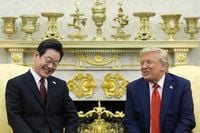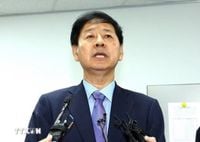It’s not every day that a $350 billion investment sparks a diplomatic tug-of-war between two of the world’s largest economies. Yet, that’s precisely what’s unfolding between South Korea and the United States as the two countries navigate the choppy waters of trade, finance, and national interests. The latest developments reveal both the promise of deeper economic ties and the perils of financial overreach, with South Korean officials sounding alarms about the risks involved in meeting U.S. demands for immediate, massive investment.
On September 27, 2025, South Korean National Security Advisor Wi Sung-lac made headlines when he appeared on Channel A News to address a hot-button issue: U.S. President Donald Trump’s assertion that South Korea would provide a $350 billion investment “immediately.” According to Wi, such an upfront payment is not just impractical—it could trigger a full-blown financial crisis for South Korea, the world’s fourth-largest economy. "We cannot pay $350 billion in cash," Wi stressed, warning that the proposal, if enforced, could push South Korea’s economy over the edge.
The tension stems from a flurry of diplomatic activity that began in July, when the leaders of both nations shook hands on a framework agreement. The deal aimed to reduce U.S. import tariffs on South Korean goods from 25% to 15%, a significant boon for South Korean exporters. In exchange, South Korea committed to a $350 billion investment in the United States, structured through loans, credit guarantees, and equity stakes—not as a lump-sum cash transfer.
But when President Trump publicly insisted on an immediate, upfront payment, South Korean officials balked. Wi Sung-lac was blunt: "This is not a negotiation tactic. Objectively, we simply cannot bear such a burden." He added that Seoul is actively discussing alternative options and firmly opposes Washington’s demands for direct control over the investment funds—a sticking point that has left trade talks at an impasse.
South Korean President Lee Jae Myung echoed these concerns just days earlier. In a September 22 interview with Reuters, Lee warned that without protective mechanisms like a currency swap agreement, South Korea’s economy—despite its $410 billion in foreign reserves—could face a crisis reminiscent of the 1997 Asian financial meltdown if forced to pay such a large sum upfront. Lee’s comments weren’t mere speculation; they were a clear signal to both domestic and international audiences that financial safeguards are non-negotiable.
Against this backdrop, South Korea’s Minister of Economy and Finance, Koo Yun Cheol, announced on September 27 that the two countries had reached a foreign exchange agreement. Speaking to reporters at Incheon International Airport, Koo explained that President Lee, during his September 25 meeting with U.S. Treasury Secretary Scott Bessent in New York, had emphasized the need for a currency swap agreement to make the $350 billion investment feasible. The U.S., for its part, acknowledged the request and promised to discuss it further, though Koo offered no specifics about the deal’s terms.
However, the plot thickened when an anonymous South Korean finance official clarified that the newly announced agreement was not directly related to the ongoing bilateral tariff negotiations or the hotly debated currency swap discussions. This distinction is crucial because, according to both sides, the framework agreement reached in July—which included the tariff reduction and the $350 billion investment—was predicated on mutual concessions and future commitments, not immediate cash transfers.
The stakes are high. As reported by TTXVN, President Lee has repeatedly cautioned that agreeing to the U.S. investment demands without ironclad financial protections could leave South Korea vulnerable to a crisis akin to the one it faced in 1997. Back then, the country’s economy nearly collapsed under the weight of foreign debt and currency devaluation, forcing it to seek an emergency bailout from the International Monetary Fund. In Lee’s words, the $350 billion investment “will not be feasible without a financial mechanism such as a currency swap agreement.”
Currency swap agreements aren’t new territory for the U.S. and South Korea. The two countries have inked such deals twice before: once during the 2008 global financial crisis and again in 2020, at the height of the COVID-19 pandemic. These arrangements allowed South Korea to access U.S. dollars in times of market stress, stabilizing its currency and shoring up investor confidence. That’s why Lee and his advisors are pushing hard for a similar safety net before committing to any massive outflows.
Meanwhile, the trade negotiations themselves have hit a snag. South Korean officials argue that the U.S. demand for control over the investment funds is a non-starter, and the lack of progress on formalizing the agreement has left both sides in limbo. According to Wi Sung-lac, South Korea hopes to finalize the deal at the upcoming Asia-Pacific Economic Cooperation (APEC) Summit, which it will host next month. President Trump is expected to attend, raising hopes for a diplomatic breakthrough—or at least a candid airing of grievances.
Adding yet another layer to the evolving relationship, South Korean Foreign Minister Cho Hyun announced on August 28 that both countries had agreed to initiate talks on nuclear fuel recycling. This move, following a summit between Presidents Lee and Trump in Washington, signals a willingness to cooperate on sensitive issues beyond trade and finance, even as contentious negotiations continue elsewhere.
For now, South Korea’s position remains clear: it’s willing to invest in the U.S. economy, but only under terms that protect its own financial stability. The country’s leaders are acutely aware of the lessons from 1997 and are determined not to repeat past mistakes. As President Lee put it, “The investment will not be feasible without a financial mechanism such as a currency swap agreement.”
With the APEC Summit on the horizon and both sides digging in their heels, the coming weeks could prove decisive. Whether the two allies can bridge their differences—or whether the specter of financial crisis will loom larger—remains to be seen. One thing’s for sure: the world will be watching as South Korea and the United States navigate this high-stakes economic balancing act.





